×


We have detected your country as:
Please click here to go to the USA website or select another country from the dropdown list.
by: Charleeda Sprinkle, Assistant Editor
This year, the choices were exceptional, as we visited places that even our long-term volunteers hadn’t seen before. Two that I’m highlighting were both on the Mediterranean Sea coastline between Haifa and Caesarea. Since it was not fully summer yet, the weather was perfect and the salt sea air was not too heavy.
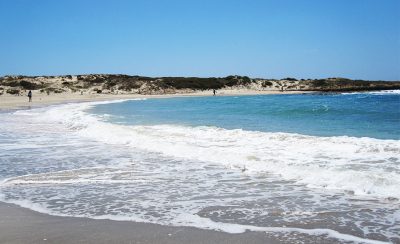 Our first stop was Dor, mentioned in the Bible several times; it’s an ancient natural seaport just north of Caesarea where archaeological digs have been underway for over 20 years. Underwater finds from the area are stored at a small museum housed in a 19th-century, two-story building built by Baron Rothschild as a glass factory. Mois Navon, a rabbi in blue jeans, was our instructor for the day. He is part of the P’til Tekhelet Foundation (www.tekhelet.com), which is run by Jewish volunteers who provide the blue dye for the blue thread in the tzitzit (tassels worn by Jewish men according to Numbers 15:38).
Our first stop was Dor, mentioned in the Bible several times; it’s an ancient natural seaport just north of Caesarea where archaeological digs have been underway for over 20 years. Underwater finds from the area are stored at a small museum housed in a 19th-century, two-story building built by Baron Rothschild as a glass factory. Mois Navon, a rabbi in blue jeans, was our instructor for the day. He is part of the P’til Tekhelet Foundation (www.tekhelet.com), which is run by Jewish volunteers who provide the blue dye for the blue thread in the tzitzit (tassels worn by Jewish men according to Numbers 15:38).
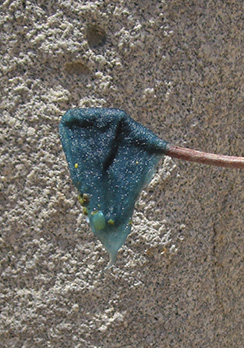 Over the centuries, the source of this dye became unknown. The film we watched told the story of how it was finally reproduced less than 30 years ago. Research done by a couple of rabbis and a chemist from 1887 to 1985 proved that the key ingredient was the glandular liquid from the animal inside the Murex shell. One of their first clues about the shell was the discovery of mounds of broken Murex shells found along Israel’s coastline (and as far north as Sidon in Lebanon) in 1864—proof that once there was a thriving blue dye business in the area.
Over the centuries, the source of this dye became unknown. The film we watched told the story of how it was finally reproduced less than 30 years ago. Research done by a couple of rabbis and a chemist from 1887 to 1985 proved that the key ingredient was the glandular liquid from the animal inside the Murex shell. One of their first clues about the shell was the discovery of mounds of broken Murex shells found along Israel’s coastline (and as far north as Sidon in Lebanon) in 1864—proof that once there was a thriving blue dye business in the area.
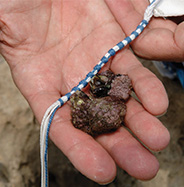 Many Jews believe this is the same “blue” mentioned in the Bible, not only for the tzitzit but also for some of the Tabernacle’s curtains and the high priest’s clothing. The Tekhelet organization now offers opportunities for tour groups to snorkel for these shells and demonstrates how the dye is made. Following the film, we walked to the beach where about half of us donned masks and snorkels. Mois showed us some Murex shells, comparing them with other shells so we knew what to look for. We were to find those with the animal still inside. After about 15 minutes in the water, our group found 66 of them, the most of any group he’d led! After our seaside class, we threw all the shells back in the sea so they wouldn’t die.
Many Jews believe this is the same “blue” mentioned in the Bible, not only for the tzitzit but also for some of the Tabernacle’s curtains and the high priest’s clothing. The Tekhelet organization now offers opportunities for tour groups to snorkel for these shells and demonstrates how the dye is made. Following the film, we walked to the beach where about half of us donned masks and snorkels. Mois showed us some Murex shells, comparing them with other shells so we knew what to look for. We were to find those with the animal still inside. After about 15 minutes in the water, our group found 66 of them, the most of any group he’d led! After our seaside class, we threw all the shells back in the sea so they wouldn’t die.
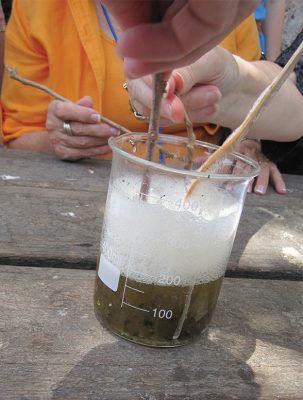 Back at the museum, sitting around picnic tables, Mois gave each table a dye-making kit: four small jars (mostly chemicals), a large glass mixing cup, and a piece of wool. The film had shown us where the shell is broken to expose the snail’s gland that has to be pierced to get the dye stuff. Thankfully, we didn’t do that part; some the dried liquid was in one of the jars. In a series of steps, we stirred in the chemicals, which produced a yellow-green liquid.
Back at the museum, sitting around picnic tables, Mois gave each table a dye-making kit: four small jars (mostly chemicals), a large glass mixing cup, and a piece of wool. The film had shown us where the shell is broken to expose the snail’s gland that has to be pierced to get the dye stuff. Thankfully, we didn’t do that part; some the dried liquid was in one of the jars. In a series of steps, we stirred in the chemicals, which produced a yellow-green liquid.
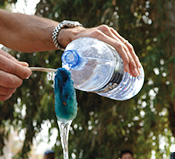 A chemical reaction takes place when the liquid is exposed to the sun, so while Mois continued to lecture, our cups sat in the sun for 10–15 minutes. We then dipped the wool into the mix, which still didn’t look blue. It wasn’t until we washed out some of the chemicals with water that the yellow-green color turned to blue. Mois concluded the lecture by reminding us of the prophecy in Zechariah 8:23 and invited us to take hold of his tzitzit!
A chemical reaction takes place when the liquid is exposed to the sun, so while Mois continued to lecture, our cups sat in the sun for 10–15 minutes. We then dipped the wool into the mix, which still didn’t look blue. It wasn’t until we washed out some of the chemicals with water that the yellow-green color turned to blue. Mois concluded the lecture by reminding us of the prophecy in Zechariah 8:23 and invited us to take hold of his tzitzit!
On the third day, we ended our retreat with a visit to Habonim Beach, just north of Dor, which some argue is one of Israel’s most beautiful beaches. Since we were there on a Wednesday rather than the weekend, we had the beach almost to ourselves. It’s part of a nature reserve, so it’s relatively untouched by commercialism. It was no surprise, then, to find the shoreline of one its coves thickly covered in shells, since it’s illegal to take anything out of a nature reserve.
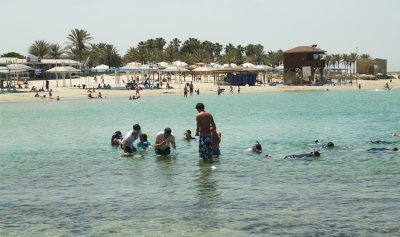 While most of Israel’s coastline is fairly straight, without many bays and coves, Habonim is an exception, having the largest number of inlets, sandy recesses, reefs, and caves. There are two nature trails that weave through its sand dunes and overnight camping is permitted. However, for most of us, the cool blue-green, crystal-clear water was much more inviting than a hot hike over a sand dune.
While most of Israel’s coastline is fairly straight, without many bays and coves, Habonim is an exception, having the largest number of inlets, sandy recesses, reefs, and caves. There are two nature trails that weave through its sand dunes and overnight camping is permitted. However, for most of us, the cool blue-green, crystal-clear water was much more inviting than a hot hike over a sand dune.
Though we couldn’t stay late enough to enjoy its famous sunsets of pink, orange, and blue, we left feeling truly refreshed—in body and spirit. All in all, Israel once again claimed our hearts, and we thanked the Lord for time to enjoy a new part of His wonderfully versatile and beautiful Land.
Photo Credit: Bridges for Peace and www.tekhelet.com
All logos and trademarks in this site are property of their respective owner. All other materials are property of Bridges for Peace. Copyright © 2025.
Website Site Design by J-Town Internet Services Ltd. - Based in Jerusalem and Serving the World.